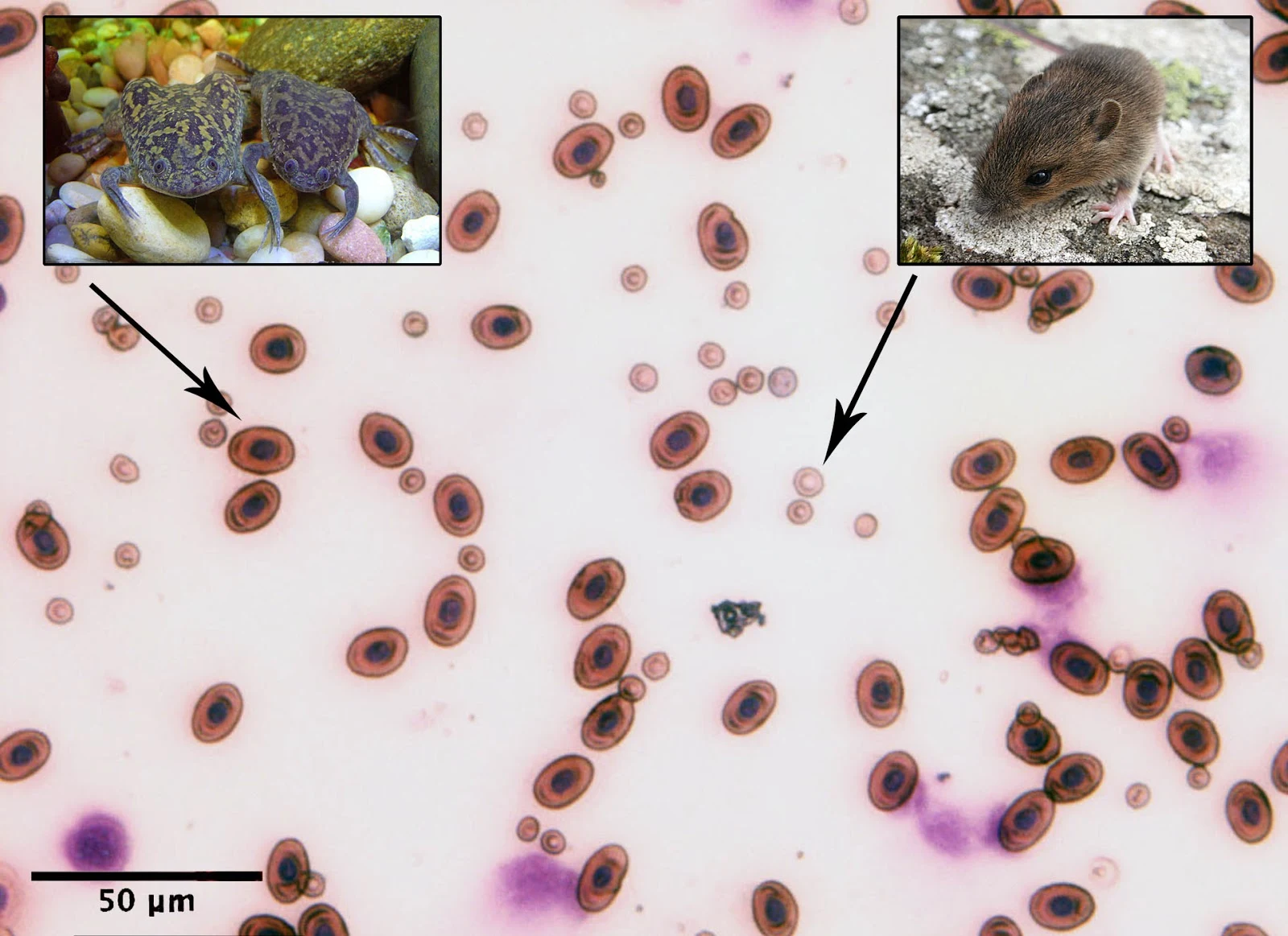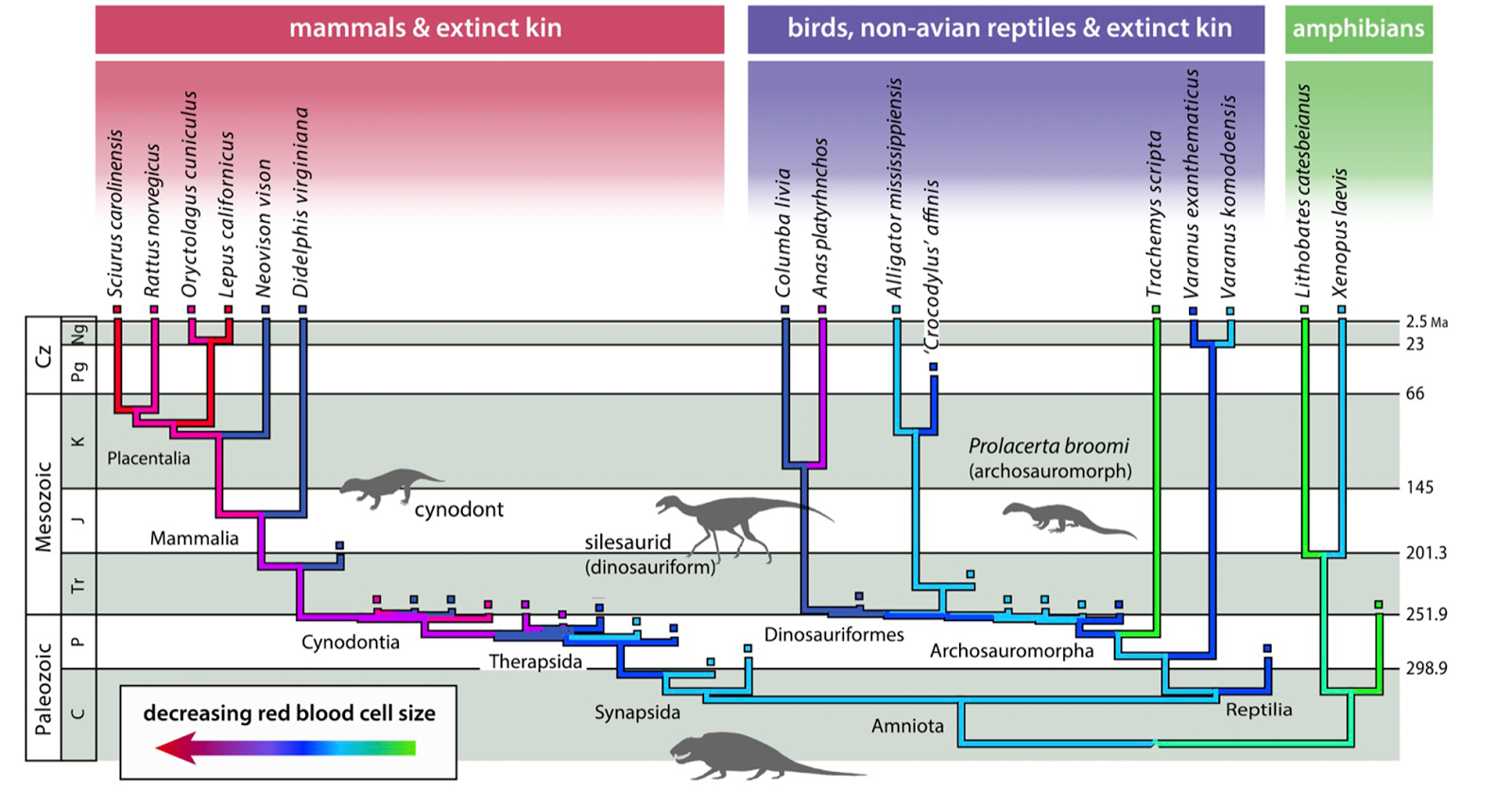One of the requirements for a highly active species, especially one capable of scurrying around, is to be able to get oxygen around the body quickly to keep the tissues supplied with enough to maintain the high metabolic activity.
This in turn means getting the oxygen-carrying blood cells into the tissues as close to the point of need as possible and this means having a rich supply of small capillaries through which small red blood cells can pass.
Why small red blood cells? Quite simply because small is more efficient. It is quicker to get oxygen out of a small cell than a large one because the surface area (through which the dissolved gas has to diffuse) is larger in proportion to the cell volume the smaller the cell is. For maths wonks, this is because the volume of a sphere (think of a cell as a sphere) is calculated by v = 4/3 π r3 but the surface area is calculated by s = 4 π r2. The important point here is that while volume increases by the cube of the radius, the surface are only increases by the square of the radius so the ratio of surface area to the volume decreases as the cell gets bigger. But the rate of diffusion is directly related to the surface area, so the amount of gas diffusing out of the cell per unit of volume also decreases as the cell gets bigger.
In mammals, the efficiency of red blood cells as oxygen carriers has also been improved by making them flattened and concave but the general principle of the ratio of surface area to volume still holds although the maths might be rather more complicated.
So, as the reptilian ancestors of both birds and mammals became more active we would expect the oxygen-carrying cells in the blood to become smaller and, more importantly from the point of view of this study, we would expect the capillaries through which these cells needed to pass to become smaller too, so the cells were brought more closely into contact with the tissues to which they were transporting the oxygen.
And this is exactly what was found when biologists from the University of Utah, the Natural History Museum of Utah and Keck School of Medicine at the University of Southern California went looking. They have found what they term a 'fossilizable indicator of athleticism' in the size of the channels through which the capillaries pass in the fossilised bones.
Highlights
- A relationship is established between bone microstructure and red blood cell size
- Small cortical canals and cell lacunae in mammals and birds reflect smaller cells
- Mammal and bird stem groups had greater aerobic capacities over earlier tetrapods
Summary
Vertebrate red blood cells (RBCs) display a range of sizes, spanning orders of magnitude in volume in different clades [ 1 ]. The importance of this size variation to diffusion during exercise is reinforced by functional links between RBC and capillary diameters [ 2, 3 ]. Small RBCs, such as those of mammals (which lack nuclei) and birds, contribute to shorter diffusion distances and permit relatively fast O2 uptake kinetics [ 4 ]. Although constraints on RBC size have been tied to the cell’s need to attend capillary sizes for effective gas diffusion [ 3 ], as well as to genome size evolution [ 5, 6 ], major questions persist concerning patterns of RBC size evolution and its paleobiological significance. Here, we evaluate the relationship between RBC sizes and bone histometry and use microstructural evidence to trace their evolution in a phylogeny of extinct tetrapods. We find that several fossilizable aspects of bone microstructure, including the sizes of vascular and lacunar (cellular) spaces, provide useful indicators of RBC size in tetrapods. We also show that Triassic non-mammalian cynodonts had reduced and densely packed vascular canals identical to those of some mammals and likely accommodated smaller, more mammal-like RBCs. Reduced channel diameters accommodating smaller RBCs predated the origin of crown mammals by as much as 70 million years. This discovery offers a new proxy for the physiologic status of the mammal and avian stem groups and contextualizes the independent origins of their increased activity metabolism.
Huttenlocker, Adam K. et al.
Bone Microvasculature Tracks Red Blood Cell Size Diminution in Triassic Mammal and Dinosaur Forerunners
Current Biology , Volume 0 , Issue 0
Unfortunately, the full paper sits behind a paywall, but the press release from Utah University explains:
...They found that extinct mammal relatives, or cynodonts, and extinct bird relatives had smaller RBCs and were likely better athletes than earlier terrestrial vertebrates. The timing of RBC-size reduction coincided with the greatest mass extinction event on Earth 252 million years ago, an event that paved the way for the age of the dinosaurs.
Huttenlocker and Farmer looked at three major lineages of terrestrial animals; the mammals and their extinct relatives, non-avian reptiles and birds and their extinct relatives, and amphibians. The researchers chose these three groups, called the tetrapods, because of their evolutionary history; they all shared the same, ancient four-legged ancestor before branching off on their own evolutionary courses by 320 million years ago.
The amphibians, including water-loving frogs and salamanders, diverged from the common tetrapod ancestor first in the early Carboniferous period, more than 320 million years ago. The mammal and reptile lineages branched off next. The extinct mammal-like cynodonts first appeared in the late Permian period, about 260 million years ago. They looked more like stout, possibly furred lizards than the mammals we see today. Around the same time, the reptiles diverged into two groups—the forebears to dinosaurs and birds, called the archosaurs, and the other non-avian reptiles.
Cynodonts and other extinct mammal predecessors exhibited RBC sizes similar to modern day mammals by the Permian-Triassic transition.
Credit: Adam Huttenlocker
At the beginning of the Triassic period 252 million years ago, 90 percent of life died off. The so-called Permian-Triassic mass extinction was the largest extinction event in Earth’s history, and left room for the survivors to diversify and fill in the newly vacant niches.
“We’re dealing with a long timescale. Right before the extinction in the early Permian and Carboniferous are these generalized-looking four-legged animals. By the time you get to the Triassic, they look more like what we see today, but still alien in some ways,” says Huttenlocker.
First, Huttenlocker analyzed the bones of 14 species of living tetrapods: six mammals, two birds, four non-avian reptiles and two amphibians. He made paper-thin sections of each animal’s forelimb bone and digitally visualized the image to see the microscopic canals and bone cell lacunae under a microscope. Then he measured the diameters of the smallest canals and lacunae and came up with equations that could predict the size of the RBCs. He tested his predictions against blood smears to measure the actual blood cell size. He found he was able to predict the size based on the microstructures in the bone.
The researchers found that mammals and birds had smaller canal and lacunae sizes than the non-avian reptiles and amphibians. Additionally, smaller blood cells corresponded to a higher density of canals, which allows oxygen to diffuse into tissues more rapidly. Huttenlocker and Farmer were confident that bone microstructure would be a proxy for RBC size in the extinct animals. They found that all of the Triassic mammal ancestors (the cynodonts) and some earlier mammal predecessors, had similar RBC sizes as modern mammals. The archosauromorphs had a wide range of cell sizes, however the smallest RBCs were about the same size as their contemporary Triassic cynodonts.
To creationists genuinely puzzled or more likely just feigning puzzlement at how scientists can claim to know things they didn't personally witness - which only ever seems to apply to things creationists don't want to be true - this paper would be disappointing if they could bring themselves to read it. It shows how, like forensic scientists and good investigative detectives, with the application of a little joined-up thinking, conclusions can be deduced from observations.
To children brought up with science where, rather than asking 'Were you there?' in order to shut down learning and divert the lesson, as the unfortunate children of creationists are taught, they asked, 'How do you know that?' these scientific findings present no problem of comprehension but rather infinite enjoyment, fascination and wonder. These more fortunate children can enjoy the thrill of finding things out and learning how science from different disciplines meshes neatly together. This can give them a comprehensive understanding of why living things are the way they are, how they got to be like this, how they are produced by Earth's history and inevitably tend towards perfection for living and reproducing in their current environment.
Finding things out is infinitely more satisfying than merely pretending to know with no regard to whether it's true or not and proudly never changing your mind. Who or what would want to deprive children of that sense of wonder than can last a lifetime?
'via Blog this'



No comments:
Post a Comment
Obscene, threatening or obnoxious messages, preaching, abuse and spam will be removed, as will anything by known Internet trolls and stalkers, by known sock-puppet accounts and anything not connected with the post,
A claim made without evidence can be dismissed without evidence. Remember: your opinion is not an established fact unless corroborated.